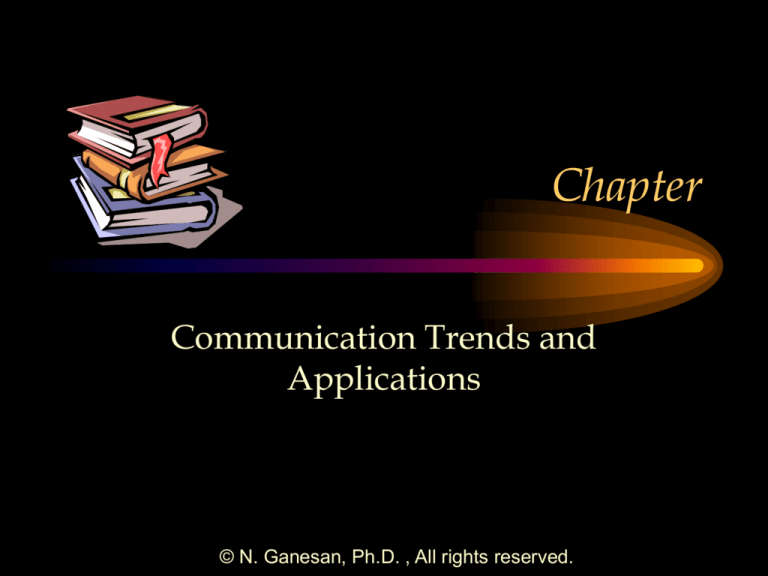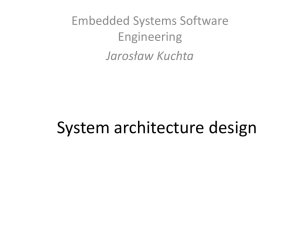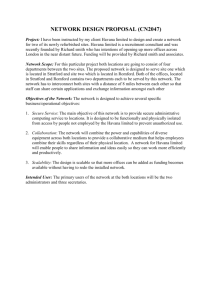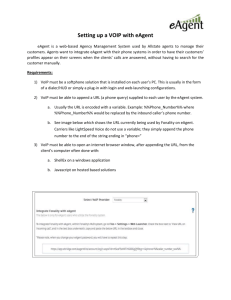
Chapter
Communication Trends and
Applications
© N. Ganesan, Ph.D. , All rights reserved.
Chapter Objectives
• Describe the status of information
communication past and present
• List the factors that led to the growth of
computer communications
• Outline a few sample communication
applications
• Discuss the evolution of Wide Area Network
communications and its current convergence
to digital technology
Module
Information Communication
Past and Present
© N. Ganesan, Ph.D. , All rights reserved.
Communication in the Past
• Known as Data Communications
– Mostly concerned with alphanumeric data
• A highly specialized topic
• Focus
– Mainframes
– Analog telecommunication technology
– WANs
Communications at Present
• Known as Information Communication
– Data, image, audio and video communications
• A necessary topic for IT professionals
• Focus
– Microcomputers
– Digital communication technology
– LANs, WANs etc.
• Internet
– Internet, Intranet and Extranet
Data and Information
Communication
Data
Computer
Data
Information
Image
Audio
Video
Real-time streaming
Audio and Video Transmission
• Requirements
– More bandwidth is required
– Real-time transmission may also be
required
• Solution
– Compression
– Streaming
• Note: Streaming includes compression
as well
Comparison of Data and information
Communication
Data and Information
Communications
Data Communications
Mainframe focused
Information
Communications
Data, image, audio and
video
Microcomputer focused
Analog technology
Digital technology
Specialized topic
General topic
Private network based
Internet based
WANs
LANs and WANs
Alphanumeric data
Key Words
•
•
•
•
•
Mainframe
Centralized
Analog
Data
Telecommunication
network
•
•
•
•
•
LANs
Distributed
Digital
Information
Computer network
(Internet)
Hosting Services
• Godaddy
• 1&1
• MediaTemple
• Yahoo hosting service
Homework
• Difference between Internet, Intranet,
Extranet
• Explore Godaddy and other hosting
services
• Download, install and experiment with
Microsoft Encoder and Audacity
– Convert between different audio file
formats
End of Module
Module
Opportunities and Certification
© N. Ganesan, Ph.D. , All rights reserved.
Opportunities in
Communications
• Specialized knowledge is required for
specialist in the communication field
– Example: Network Engineer
– Certification examinations are available for
attesting to the special skills
• Some knowledge of communications is
required of all in the computer field
Certification
• Microsoft Certification
– MCSA & MCSE
• CISCO Certification etc.
• Network+ Certification
• Different vendors offer certifications at
different levels of expertise
– Contact their web sites for further
information
Certification Websites
• Microsoft
– http://www.microsoft.com/learning/mcp
/certifications.mspx
• CISCO
– http://www.cisco.com/en/US/learning/l
e3/learning_career_certifications_and_lear
ning_paths_home.html
Key Words
• Microsoft certifications
– MCS*
• CISCO certification
• Network+
End of Module
Module
Information Communication
Growth Factors
© N. Ganesan, Ph.D. , All rights reserved.
Information Communications:
Growth Factors
• Internet
• Fast access technologies for the Internet ramp
• Emergence of microcomputers as a serious
business and home computing tool and the
focus on connectivity
• Move from large mainframe based
infrastructure to LAN based structures
• Client-server computing architectures
• Emerging concept of terminal servers
Growth Factors Continued
• Home networking
• Digitization of telecommunication lines
• Wireless networking
• Multimedia on the Internet
• Internet security
• Virtual Private Network
• Voice over IP (VoIP)
Homework
• Fast access technologies
– DSL, Cable, T1, T3, OC1, OC2
– Home fiber connections
• IBM business computers
– Replacements for mainframes
End of Module
Module
Evolution Physical Network
Architecture
© N. Ganesan, Ph.D. , All rights reserved.
Evolution
• Physical architecture
– From mainframes to LAN based
• Functional architecture
– Centralized mainframe based architecture to LAN
based client-server architecture
– In the case of LAN based architecture, clientserver evolved following the initial introduction of
the peer-to-peer network architecture
– Client-server architecture is now followed by
terminal server architecture
Early Mainframe-based
Centralized Architecture
External Analog
Lines
Mainframe
MiniComputer
Term.
Front End Processor
Concentrator
Term.
Term.
Modem
Server
Distributed LAN Based Architecture
LAN
Mainframe/
Minicomputer
Systems
External Digital/
Analog Lines
Fiber Optic Backbone
(FDDI) or Switched Network
Connectivity
Modem
Gateway
LAN
WAN (Internet)
Gateway
(TCP/IP)
Current Trend in
Distributed Architecture
Source:
CISCO
Major Components of the
Distributed Architecture
•
•
•
•
•
•
•
•
Clients
Servers
Network interface cards
Cables (copper and fiber)
Switches
Routers
Internet ramps
Internet
Key Words
•
•
•
•
Mainframe based
Centralized
Distributed
Fiber ring
• Fiber switches
End of Module
Homework
• Explore some of the Catalyst switches
at Cisco
Module
Evolution of the Network
Functional Architecture
© N. Ganesan, Ph.D. , All rights reserved.
Network Architectural Evolution
• Mainframe
• LAN
– Peer-to-Peer
– Client Server
•File server
•Application server
•Terminal server
Peer-to-Peer Networking
• Initial architecture of the LAN prior to
client-server architecture
• Each client operates on equal footing in
sharing resources
• Unlike the client-server architecture,
there is no server on the network in
peer-to-peer networking
P2P Sharing
• Basic sharing is supported
– Files
– Printers
– Internet connection
• Large scale sharing of databases and
other business applications are not
included in P2P sharing
Client-Server Evolution
• Client-server architecture is always identified
by the presence of a server
• The evolution of client-server can be traced to
three sub-architectures that are based on the
functional feature of the server
– File server
– Application server
– Terminal server
Preview of File Server
Computing
Back-end data storage.
Server
Clients
Front-end computing
All the processing of the application is done at the client.
Preview of Application Server
Computing
Back-end data storage and local retrieval of data.
Server
Clients
Front-end interface and data manipulation tools.
Application processing is shared between the client and
the server.
A Preview of Terminal Server
Computing
Powerful
Terminal
Server
Extensive back-end data storage,
retrieval and Processing
Thin Clients
Front end processing limited to terminal operations
Factors Used in the Comparison of
Architectures
• Point of execution of applications
• Network traffic
• Security
• Hardware/Software requirements
• Total Cost of Ownership (TCO)
Path of Evolution
More power to the user
Peer-to Peer
Distributed
Network
Centralized
Mainframe
Terminal
Server
Application
Server
Reduced cost of ownership
File Server
Better management of shared data
Homework
• Browse for wiring closet, RJ-45 patch
cables, wiring rack, punch block etc.
End of Module
Module
Digitization of
Telecommunication Lines
© N. Ganesan, Ph.D. , All rights reserved.
Digitization Of Telecom Network
• Initial telecom network was based on analog
technology
– Copper wire
– Electronic transmission
– Coaxial cables and twisted pair cables
• Current telecom
– Copper wires and fibers
– Electronic and optical transmission
– Fiber cables and twisted pair cables
Digital WAN Carrier Technologies
• DSL
• ISDN
• T1, T3 etc.
• OC1, OC3 etc.
WAN Communication Technologies
• FDDI and CDDI
• Frame Relay
• Asynchronous Transfer Mode (ATM)
Voice Transmission
• Past is based on analog technology
• Currently, it is moving to digital
technology
– VoIP
Access Speeds
• Fastest speed of an analog modem is around
56K bps
• Newer and mostly digital access technologies
such as DSL can operate at faster speeds
– Download speed is usually in Mbps
– Upload speed is in Kbps
• ADSL and SDSL
– In SDSL both upload and download speeds
are the same
Typical DSL Speed
• Upload
– 128K bps
• Download
– 1.3M bps
Some DSL Providers
• Covad
– http://www.covad.com/products/a
ccess/dsl.shtml
• SBC
– http://www02.sbc.com/DSL/
• DSL Extreme
Testing the Access Speed
• The current bandwidth of a connection
can be tested by accessing websites that
test the connection speed
– www.dslreports.com
– www.2wire.com
Access Security
• www.grc.com
Summary of Access Technologies
for the Internet
End of Module
Module
Internet Architectures
© N. Ganesan, Ph.D. , All rights reserved.
Architectures
• Internet
• Intranet
– An Internet restricted to the company’s
own perimeter
• Extranet
– Intranet extended to include outside
organizations dealing with the
organization
Internet Defined
Internet Backbone
run by major carriers
(TCP/IP etc.)
SOHO
User
Internet
Service
Provider
(ISP)
Internet
Service
Provider
(ISP)
Individuals
Company
Network
Firewall
Internet
Intranet Defined
Internal Company
Backbone
(TCP/IP)
Departmental
LAN
Departmental
Computer
System
Mini or Mainframe
Computer systems
Extranet Defined
Other businesses
dealing with
company A.
Internet
Company’s
Intranet
Business
Associates
Virtual Private Network
(VPN)
A Note on VPN
• Created by tunneling into the public
network
• Tunneling is done largely by encrypting
the computer data
Virtual Private Network (VPN)
Internet
Fire Wall
Company’s
Intranet
Point-to-Point Tunneling
Protocol (PPTP)
End of Module
Module
Internet Access
© N. Ganesan, Ph.D. , All rights reserved.
Access
• Analog Access
• Digital Access
• Remote execution
• Telecommuting
Analog Internet Access
Software:
Web Browser
Serial Port
Micro
Gain access to the
resources on the WWW.
Modem
Access provider
ISP
Internet
Software:
Web Browser
Digital Internet Access
Network
Port
Micro
Gain access to the
resources on the WWW.
Access provider
DSL
Modem
ISP
Internet
Computer to Computer Access
Gain access to a company’s
mainframe to run Unix applications
Modem
Micro
Public
Switched
Network (PSN)
Software: ProComm Plus, Hyper
Terminal, PCAnywhere, Remote
Desktop
Micro
Modem
Telecommuting
Terminal Services
Satellite
Office
PSN
Home
Terminal Services
Terminal Server
Main Office
Telecommuting Options
• Employer supported
– Previous example falls into this category
where the employer provides access to the
office computer from home
– Example: Terminal services
• User initiated
– Gain access to one’s computer in the office
– A remote control software is required
– Examples: XP Remote Desktop and
GoToMyPC
Some Communication Software
• Hyper Terminal
• Telnet
• FTP
• Procomm Plus
• Remote Desktop
Homework
• Dlink home network router
• Linksys home network router
Remote Operation
• Gotomypc
• logmein
End of Module
Module
Networks
© N. Ganesan, Ph.D. , All rights reserved.
Computer Networks
• Simple
– A single LAN
• Intermediate
– Departmental
• Enterprise
– Campus LANs and organizational LANs
• Advanced
– WANs such as an Internet based Virtual Private
Networks (VPNs)
Typical Wired LAN
Client OS
Client 1
Switch
Windows
2000/2003,
Linux
Windows XP/Vista; Linux
Client 2
Server:
Network OS,
Applications,
Data etc.
Client 3
Server Operating
System
Typical Wireless LAN
Client OS
Client 1
Windows XP/Vista; Linux
Client 2
Client 3
Wireless NIC
Wireless Access
Point
Server:
Network OS,
Applications,
Data etc.
Windows
2000/2003
Server,
Linux
Some LAN Applications
•
•
•
•
•
•
Share business applications
Share data
Share printers, modems etc.
Share the Internet and Internet resources
Send electronic-mail
Engage in audio/video streaming and
conferencing
• Act as the infrastructure for the .net or J2EE
architecture
End of Module
Module
Network Security
© N. Ganesan, Ph.D. , All rights reserved.
Network Security
• Network security is an important issue
given the fact that many computers are
connected to the Internet using
broadband connections
General Security Threats
• Viruses
• Denial of service attack
• OS vulnerabilities
• E-mail vulnerabilities
• Macro execution vulnerabilities
• Ect.
General Security Measures
• Anti-virus
• Anti-spyware
• Anti-spam software
• Firewalls
– Both software firewalls and hardware
firewalls can be installed
Secure Communications
• Cryptography
– Encryption
• Virtual Private Network (VPN)
• IPSec and other secure protocols
• Digital signatures
Examples of Protocols for Secure
VPN
• PPTP
• IPSec with encryption
• IPSec with L2TP
• SSL with encryption
Examples of Protocols for Trusted
VPN
• MPLS with constrained distribution of
routing information through BGP
("layer 3 VPNs")
• Transport of layer 2 frames over MPLS
("layer 2 VPNs")
(Source: http://www.vpnc.org/vpnstandards.html )
Encryption
•
•
•
•
•
•
•
•
PKI
RSA ?
MD5 ?
PGP
SSH
HTTPS
DES
AES
End of Module
Module
Wide Area Networks
© N. Ganesan, Ph.D. , All rights reserved.
WAN: The Early Days
• Telecommunication needs
– Centered on analog technology
• Data communication needs
– Centered around digital technology
• Digital to analog interface
– For long distance computer
communications
Long-distance Communications
Modulation
Interface
Digital
Digital
Analog
Plain Old Telephone Service (POTS)
Initial WANs
• Overcome the limitations of general purpose
analog telephone lines
• Better conditioned lines such as leased lines
were used on the network segment
• Driven by a collection of computers to route
the data traffic from its source to its
destination
• Arpanet was the first WAN that was created
A Summary of the Basic
Components of the WAN
Routing devices
Leased lines
Computers/
Routing algorithms
Present Status of WANs
• Information is carried in digitized form
• Digital communication lines
– Over copper wire
– Over fiber-optics
• Digital merger
– Telecommunications
– Computer communications
WANs: Present and Future
• Fully digital
• Technologies
– Frame Relay
– ATM
• Point-to-point digital communication
will become the norm
Emerging WAN
ATM Switches
ATM operating at several
hundred Mbps
Digital
Ramp
Business
Computer
System
High speed digital lines:
OC3, OC48 etc.
Summary:Possible Convergent
Technology
• Networks
–
–
–
–
Local
Enterprise
Wide area
Global
ATM
Point-to-point ATM connection may become
possible?
ATM Possibility
Internet Backbone
Client 1
Client 2
1 Gbps
25 Mbps
300 Mbps
Server
100 Mbps
ISP
Likely Scenario
• Ethernet on the desktop
• Possibly, ATM on the backbone
Ethernet Challenge
Client 2
Client 1
10 Gbps
1 Gbps
(Gigabit)
Hub
ISP
Server
10 Mbps/
100 Mbps/
1 Gbps/
10 Gbps
100 Mbps
(Fast)
10 Mbps
1 Mbps
(Past)
Current Ethernet Speeds
• 1G bps used widely
• 10G bps is gradually gaining grounds
• 100G bps is on the horizon
Net Result
• At the local level (LAN) Ethernet will
remain the technology of choice for the
foreseeable future
• At the WAN level, ATM will dominate
over other WAN technologies
The Digital Future: Fusion
• Digital fusion
– Computing
– Telecommunications
• Use of computers and the Internet in all
forms of communications that would
include data as well as all forms of
media
– An example is Voice over IP (VoIP)
Possible Scenario
• IP based universal digital
communication over the Internet with
IP addresses as the point of
identification
– Data, voice and video communication will
be done over the Internet
Explore High-speed Internet
• 10 Gpbs solutions
End of Module
Module
Sample Applications
© N. Ganesan, Ph.D. , All rights reserved.
Some Application Areas
• Networking
– Various server applications such as
database server application, messaging
server application etc.
• Web hosting and E-commerce
• Voice over IP (VoIP)
• Network Security
End of Module
Module
Voice over IP (VoIP):
Effect of Evolution
© N. Ganesan, Ph.D. , All rights reserved.
Voice Over IP (VoIP)
• VoIP is the digital replacement for the
traditional analog phone line
• VoIP is based on the Internet
– It is packet switched as opposed to the
traditional phone service that is circuit
switched
Voice Over IP Growth
• Growth of VoIP is fuelled by the economy of
using the Internet and the technological
advantage of the digital technology
• It signifies the inevitable use of digital
technology and the Internet to carry voice
• VoIP is poised to grow and probably become
the de facto public voice carrier technology
VoIP Challenges
• Latency inherent to the IPv4 protocol
• Availability of bandwidth
VoIP Remedies
• Newer protocol such as IPv6 is
designed to address latency
• Faster Internet backbones such as those
using Optical Carrier (OC) lines and
ATM transport technologies are being
introduced to increase the bandwidth of
the communication lines
Long Term Developments
• Indications are that residential
connections in the long term would
evolve into Internet connections
replacing the phone connection
Business and Residential End Points
• Instead of identifying an end point in a
business or a residence with a phone
number, it is plausible that the end
point could be identified with a number
similar to an IP address
VoIP Application: Broadband Phone
• Broadband phone may be touted as the
first real sign of convergence between
computer and telephone networks
• VoIP application in the form of
broadband phone will also contribute to
the growth of communication on the
Internet
Broadband Phone
• Uses a DSL or cable modem connection
• Sample vendor
– Vonnage
• Broadband phone is known as an
Internet appliance
Emergence of Internet Appliances
• Internet appliances are devices that can
be used without explicit programming
• The software code necessary will be
stored in firmware in the appliances
• Functionalities of the appliances could
well be chosen with the use of buttons
that may resemble the buttons on a
telephone dial pad
Internet Appliances
• A broad range of Internet appliances will
then become available for residential use with
the broadband phone featuring prominently
as perhaps the most used Internet appliance
• Other Internet appliances may include
Radios, Interactive TV, Evolving Palm Pilots
etc.
End of Module
End of Chapter
END OF MODULE
END OF CHAPTER








